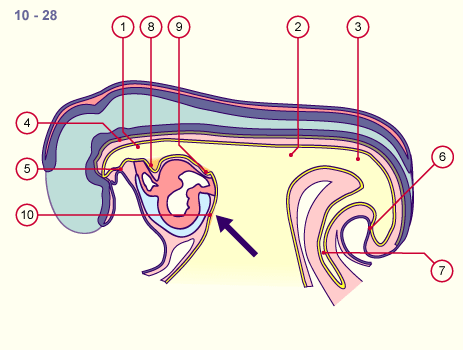|

|
|
|
19.7 Liver, gall bladder and passages
|
|
|
|
Already in a young embryo (in stage 10, ca. 28 days,  10 10 ) is the liver recognizable as an epithelial budding of the endoderm at the transition from the intra- to extraembryonic part of the umbilical vesicle below the cardiac anlage. ) is the liver recognizable as an epithelial budding of the endoderm at the transition from the intra- to extraembryonic part of the umbilical vesicle below the cardiac anlage.
|
|
|
| Fig. 31 - Anlage of the liver in stage 10 (ca. 28 days) |
|
Legend |

1
2
3
4
5
|
Foregut
Midgut
Rectum
Notochord
Oropharyngeal membrane /
stomodeum |
|
|
6
7
8
9
10 |
Cloacal membrane /
proctodeum
Allantois
Anlage of the thyroid
Anlage of the lungs
Anlage of the liver |
|
|
|
|
Fig. 31
The liver stands in a close relationship with the heart. The first indications of a sprouting (arrow) can be seen in very young embryos.
|
|
|
|
|
From the distal part of this originally endodermal sprout arises the actual liver, the middle bud forms the gall bladder with its passage and from the caudal bud arises the ventral anlage of the pancreas.
Liver development is not simply a sprouting of liver cells into the transverse septum. Instead, complex interactions between the mesoderm and the epithelial cells of the endoderm take place. It is only with the formation of the vessel system and the development of the portal vein that the definitive organ structure is assembled. (3).
|
|
|
|
More info
|
|
Recent studies on mouse embryos have shown that embryonic hepatocytes stem from endodermal cells that, without induction by mesodermal cells of the transverse septum, normally develop into pancreas cells. This determination to liver cells is achieved mainly through two signalling factors: FGF (fibroblast growth factor) and BMP (bone morphogenic protein) released by the mesodermal cells of the transverse septum. (4, 5)
|
|
|
|
|
|
|

